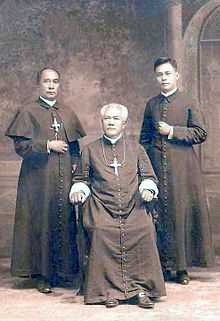Gregorio Aglipay
| Gregorio Aglipay Cruz y Labayan Obispo Maximo I | |
|---|---|
 | |
| Religion |
Catholic Church (former) Iglesia Filipina Independiente |
| Personal | |
| Born |
5 May 1860 Batac, Ilocos Norte, Spanish Philippines |
| Died |
1 September 1940 (aged 80) Manila, Philippines |
| Senior posting | |
| Based in | Laoag, Ilocos Norte, Philippines |
| Title | First Supreme Bishop |
Period in office | 1902 - 1 September 1940 |
| Successor | Santiago Antonio Fonacier y Suguitan, Obispo Maximo II |
| Family | |
| Spouse | Pilar Jamias y Ver |
Gregorio Aglipay Cruz y Labayan (Latin: Gregorius Aglipay; 5 May 1860 – 1 September 1940) was a former Catholic priest who became the first head of the Iglesia Filipina Independiente, a Protestant sect in the form of a national church in the Philippines.
Known for inciting patriotic rebellion among the Filipino clergy, he was also a political activist who became acquainted with Isabelo de los Reyes, who would start a Protestant church named after Aglipay in 1902.
Aglipay was previously excommunicated by Archbishop Bernardino Norzaleda y Villa of Manila in May 1899, upon the expressed permission of Pope Leo XIII. Aglipay later joined Freemasonry in May 1918. Aglipay later married Pilar Jamias y Ver from Sarrat, Ilocos Norte in 1939 and then died one year later. Followers of Aglipay through the church colloquially sometimes refer to their membership as Aglipayans.
Early life
Born in Batac, Ilocos Norte, Aglipay was an orphan who grew up in the tobacco fields in the last volatile decades of the Spanish occupation of the Philippines. He bore deep grievances against the colonial Spanish government of the islands, stemming from abuses within the agricultural system and the radical ecclesiastical reforms he championed. Arrested at fourteen when a tobacco-picking worker for not meeting his tobacco quota, he later moved to the capital of Manila to study law under the private tutelage of Julian Carpio.[1]
After two years of study under Carpio, Aglipay continued his studies at the Colegio de San Juan de Letran and at the University of Santo Tomas. After obtaining his degree, he then entered the seminary in Ilocos Sur in 1883 and was ordained to the priesthood seven years later. He began a career as an assistant priest in various parishes around the main northern island of Luzon. Despite being a priest, Aglipay, like other revolutionaries, joined Freemasonry.[2]
Revolution

In 1898, the Katipunan was led by the Supremo, Andrés Bonifacio. Archbishop Bernardino Nozaleda asked Aglipay to confront the revolutionary leaders, offering them a level of autonomy in the future for the Philippines if they would end the rebellion. Aguinaldo, in turn, sent Colonel Luciano San Miguel to Aglipay with the intention of getting him to join the rebellion. In the course of Aglipay's journey north, the Philippine–American War started.
When Aglipay returned to Manila and discovered that the Americans had attacked, he joined the revolution. On 20 October 1898, he was appointed Military Vicar General of the revolutionaries. The next day, Aglipay sent a letter to various members of the clergy asking them to ask Rome to appoint Filipinos in all local church positions. On 5 May 1899, Archbishop Bernardino V. Nozaleda excommunicated Aglipay. [citation needed]
Following the end of the war in 1902, Isabelo de los Reyes was working towards the formation of a national church, that is independent of Rome. On 3 August he suggested that Aglipay be its first bishop. Aglipay, a devout Catholic at the time, was reluctant, and initially did not accept. He was approached by Jesuit priests, Francisco Foradada and Joaquin Villalonga. They attempted to get him to sign a document swearing his continued allegiance to the Catholic Church.
Aglipay said he would sign it if the Church would continue to work towards appointing more Filipino priests. Foradada asked him why he wanted more Filipino priests so badly, as he (a Spaniard) felt they were inefficient and vicious; this statement so offended Aglipay (some reports say that he punched Foranda afterwards). He severed his ties with the Catholic Church, and accepted de los Reyes' offer to establish an independent church. On 18 January 1903, Aglipay was appointed Supreme Bishop of the "Philippine Independent Church" by the bishops of the dioceses of Manila, Cavite, Nueva Ecija, Isabela province, Cagayan, Pangasinan, and Abra province. [citation needed]
During the theological discussions while visiting other churches while travelling abroad, Aglipay rejected the belief in the Trinity, becoming theologically accepting of the main Unitarian belief however, his own church refused to accept his amended theology. Aglipay's unitarian and progressive theological ideas were evident in his "novena", "Pagsisiyam sa Birhen sa Balintawak", 1925 [3] and its English translation, "Novenary of the Motherland", 1926.[4]

Later life
Aglipay ran for elections as President of the Commonwealth along with the Partido Komunista ng Pilipinas Norberto Nabong in a joined Republican-Communist Party ticket in 1935, but lost to Manuel L. Quezon and Sergio Osmeña of the Nacionalista Party. He married D. Pilar Jamias y Ver in 1939 since his church permits married clergy, but Aglipay died the following year on 1 September 1940.
Veneration
Aglipay is honored with a feast day on the liturgical calendar of the Episcopal Church in America on 5 September.
See also
References
- ↑ University, Princeton. "The Catholic Historical Review, Volume 4". American Catholic Historical Association, 1919, p. 320.
- ↑ "Famous Filipino Mason – Bishop G. Aglipay". Most Worshipful Grand Lodge of the Philippines. Retrieved 2010-01-12.
- ↑ Aglipay, Gregorio, Pagsisiyam sa Birhen sa Balintawak, 1925
- ↑ Aglipay, Gregorio, Novenary of the Motherland, 1926
Sources
- Halili, Christine N. (2004) Philippine History, pp 192–93. ISBN 9712339343.
| Wikimedia Commons has media related to Gregorio Aglipay. |
| ||||||||||||||||||||||||||
|